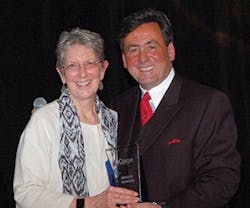Similar to “the wave” at a ball game, the high energy level and excitement carried through the entire Design Connections Healthcare conference held in Ponte Vedra, Fla., in February. The gathering, sponsored by interiors+sources and nGage Events, included interdisciplinary attendees and education that focused on healthcare trends, care models, technology, product design, sustainability, adverse events and risk assessment, and research, in addition to interior design within acute, outpatient, and long-term care settings.
Value-Based Health and Wellness
Whitney Bowman Zatzkin started the conference talking about trust: how clinicians must embrace the need for patient acceptance, no judgement, and trust developed between the practitioner and the patient—all impacting health outcomes. A “Healthcare Trends” panel discussed creative outpatient care models and research being completed by Zatzkin’s Flip the Clinic, which is changing paradigms through evidence; community-based behavior health programs as presented by Dr. Andy Trentacoste from Creative Health Services; and my own information on multi-generational communities as the focus for younger and older generations alike being the future of multi-family development.
Designers are encouraged to keep an eye out for a new PBS Special, “Thriving in Place”—a replacement for the outdated terminology, “aging in place”—supporting growing and purposeful life opportunities at any age. Technology is clearly a part of supporting longevity, as discussed by Helen Lanes from Inova Health System and Michael Mann from Geriatrics Life Care; but empathy, human touch, and engagement have to be maintained for a total solution to be effective and meaningful for successful long-term living.
Informing Product Design
Donald Strum, principal of Product Design for Michael Graves Architecture & Design, provided inspirational examples of innovative, thoughtful, and functional products for the healthcare space that are being conceptualized and produced by the firm’s product design team.
Attending manufacturers provided educational sessions for the design community, providing case studies, receiving designer feedback, and reviewing research in healthcare design. One-on-one sessions were held between supplier reps and attendees to review specific needs and trends related to product applications.
In addition, the following four key areas were discussed in relation to healthcare settings:
Cleaning and maintenance. Historically there has been a disconnect between cleaning and disinfection protocols and manufacturer recommendations for cleaning. Healthcare providers follow different guidance, usually influenced by the Center for Disease Control (CDC) as part of quality assurance and infection control measures. Further, environmental services (ES) staff usually have a high turnover rate, reducing the effectiveness of training. (There is always need for continual in-service ES training, and often teams are understaffed.) These factors particularly impact vinyl products in healthcare settings. One specific issue raised at Design Connections is having consistent cleaning methods developed to clean and disinfect vinyl products that reinforce and support durability and ease of cleaning. For example, bleach- and hydrogen peroxide-based products are often utilized on vinyl upholstery, which is a perfect fit for durability, but the surfaces are not rinsed after application as part of the overall cleaning process. Because of the concentration of cleaning chemicals, that eventually impacts the integrity of the products. The goal is for an interdisciplinary group to be assembled to discuss these issues to make recommendations to organizations, such as the Association for the Healthcare Environment (AHE) of the American Hospital Association, to better protect vinyl products that have an important role in reducing the rate of infection within healthcare settings.
PageBreakProduct sustainability. Regarding sustainability, the panel “Becoming Certified: A Product’s Sustainability Story,” was presented by The Vinyl Institute with the goal of providing designers with an understanding of the robust process required for a product to become third-party certified. The advent of the LEED v.4 Pilot Credit focusing on multiple-attribute standards was one of the discussion points, and it is clear that there is a need for further education on a life-cycle approach and multiple attributes versus single attributes in evaluating and specifying sustainable products.
Risk assessment. The avoidance of “adverse events” within healthcare settings was discussed in relation to research and outcomes, interior design recommendations, and product selection. Ellen Taylor, vice president of research for The Center for Health Design, outlined the drivers behind the measures and the role of design in complex healthcare systems. All risk cannot be eliminated, but taking an evidence-based approach, including the evaluation of safety and satisfaction, provides a framework for decision making focused on improved outcomes. In addition to reviewing patient, resident, and staff satisfaction, adverse events including healthcare-acquired infections, medication errors, and falls were reviewed with interdisciplinary teams in subsequent breakout sessions. Product-solution examples include the need to further develop composite products for ease of cleaning and maintenance; quality of workmanship for custom casework, providing additional opportunities for furniture manufacturers to develop well-made, integral solutions; and the need for clarifications of slip-resistance and coefficients of friction for LVT products, ceramic tile, and other flooring products to positively impact reduction of fall risk. Improving the environment is part of the solution to mitigate adverse events when utilizing a multidisciplinary approach for review of complex issues.
The WELL standard. Randy Fiser, CEO of ASID, presented on the importance of health and wellness in not only healthcare settings, but in any space that is occupied. The new ASID headquarters in Washington, D.C., recently received LEED v.4 Platinum, and is on track for becoming WELL Platinum, as well. The WELL Living Lab has just been completed and is setting a research agenda. Guest speaker Barbara Spurrier, senior vice president of Delos Ventures, is the administrative director of the Well Living Lab, which includes adjustable spaces providing opportunities for research in both commercial and residential scenarios. There are many healthcare settings that could be set up as vignettes within the Lab, including evaluation of Indoor Environmental Quality (IEQ).
The Wrap-Up
Design Connections also included a competition and awards. “Wagons of Love” was a contest to create themed wagons to be used for patient transport at the Wolfson Children’s Hospital in Jacksonville, Fla. The Crossville-sponsored team created the winning design—the “Blue Dog.”
The Designer of the Event honor went to Teri Bennett, lead interior designer at Johns Hopkins, and Kwalu Furnishings and Sunbrella Fabrics were both selected by the attendees for top educational and product-information presentations.
I encourage everyone to stay tuned for the next Design Connections Healthcare conference, which is currently under planning and development for December. There will be four verticals coming together to create a larger event, with four smaller specialty conferences within one venue: healthcare, education, hospitality, and workplace. Hope to see you there.
Jane Rohde is the founding principal of JSR Associates, Inc., located in Ellicott City, Md. She champions a global cultural shift toward de-institutionalizing senior living and healthcare facilities through person-centered principles, research and advocacy, and design of the built environment. Clientele includes non-profit and for-profit developers, government agencies, senior living and healthcare providers, and design firms. Rohde speaks internationally on senior living, aging, healthcare, evidence-based design, and sustainability. For more information or comments, please contact Rohde at [email protected].
About the Author

Jane Rohde
AIA, FIIDA, ASID, ACHA, CHID, LEED AP BD+C, GGA-EB
Jane Rohde, AIA, FIIDA, ASID, ACHA, CHID LEED AP BD+C & GGA – EB: Jane Rohde is the founding principal of JSR Associates Inc. in Catonsville, MD. JSR Associates Inc. celebrates 23 years of consulting services in 2019. Jane is the recipient of the 2015 Environments for Aging Changemaker Award and in 2018 she received the ASID Design for Humanity Award, was recognized as an Honorary Alumni of Clemson University’s Architecture + Health program, and has been honored as one of 10 notable Women in Design. For more information or comments, please contact Jane Rohde at [email protected] or “Chat with Jane” at www.jsrassociates.net.
